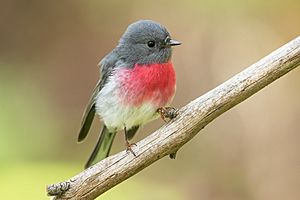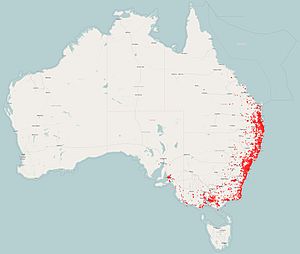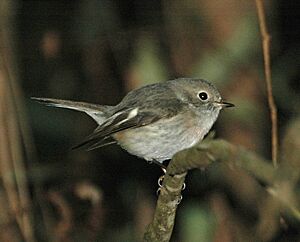Rose robin facts for kids
Quick facts for kids Rose robin |
|
|---|---|
 |
|
| Male | |
| Conservation status | |
| Scientific classification | |
 |
|
| The distribution of the rose robin Data from The Atlas of Living Australia |
The rose robin (Petroica rosea) is a small bird that sings. It lives in Australia. This bird is special because the male and female look very different. This is called sexual dimorphism. The male has a bright pink chest. Its back is dark grey, and its tail is black with white tips. The female is mostly grey-brown. Both birds have a small black beak and eyes.
Rose robins are found only in Australia. They live in forests, especially in valleys and wet areas. You can find them from Queensland down to southeastern South Australia, usually near the Great Dividing Range.
Contents
About the Rose Robin
The rose robin is a small bird, about 11 cm (4.3 in) long. That's about the length of your hand!
How to Spot a Rose Robin
The male rose robin is easy to spot. It has a bright pink chest and belly. Its head, throat, and back are dark grey. It also has white spots on its forehead and tail.
The female rose robin looks much plainer. She is mostly grey-brown on top and grey-white underneath. She has small white marks on her wings and near her beak. Both male and female rose robins make a "tick" sound.
Where Do Rose Robins Live?
Rose robins live in eastern and southeastern Australia. You can find them from Rockhampton in Queensland, through New South Wales and Victoria, and into southeastern South Australia. They do not live in Tasmania.
These birds like wet forests and rainforests. They prefer valleys and gullies. When the weather gets cooler, they might move to drier forests. Sadly, building and clearing forests can make it hard for rose robins to find homes. Because of this, they have disappeared from some areas. However, they are still found in special conservation areas, like some parks in Melbourne.
What Do Rose Robins Eat?
Rose robins usually fly alone or in pairs. They like to find their food high up in the trees. Their main diet is insects and spiders. They are very good at catching their prey while flying!
Unlike some other robins, the rose robin does not usually go back to the same branch after catching food. They eat many different kinds of insects and spiders. This includes caterpillars, wasps, cicadas, beetles, flies, and ants.
Rose Robin Families: Reproduction
Rose robins usually have babies between September and January. They can raise one or two groups of young birds during this time.
Their nest is a neat, deep cup. They build it from moss and fern pieces. They use spider webs, feathers, and fur to hold the nest together. They also put lichen on the outside to help it blend in. The nest is usually placed in the fork of a large tree, about 10–20 m (33–66 ft) (33-66 feet) above the ground.
The female lays two or three eggs. The eggs are dull white with hints of blue, grey, or brown. They also have dark grey-brown spots. Each egg is about 17 mm by 13 mm in size. Sometimes, other birds like the pallid cuckoo or brush cuckoo will lay their eggs in a rose robin's nest. This means the rose robin will raise the cuckoo's babies instead of its own.
See also
 In Spanish: Florencia rosada para niños
In Spanish: Florencia rosada para niños



